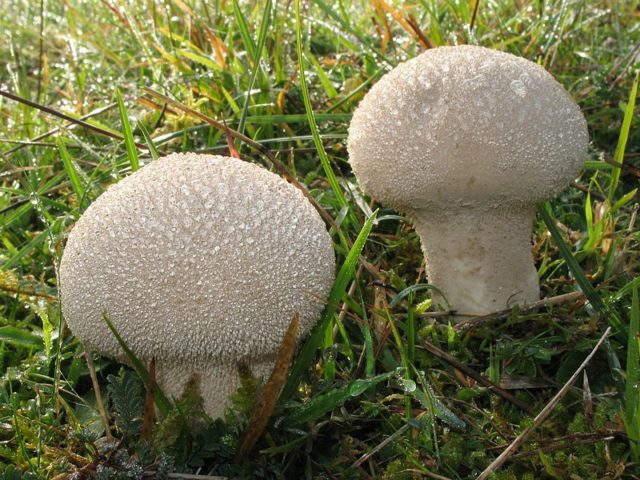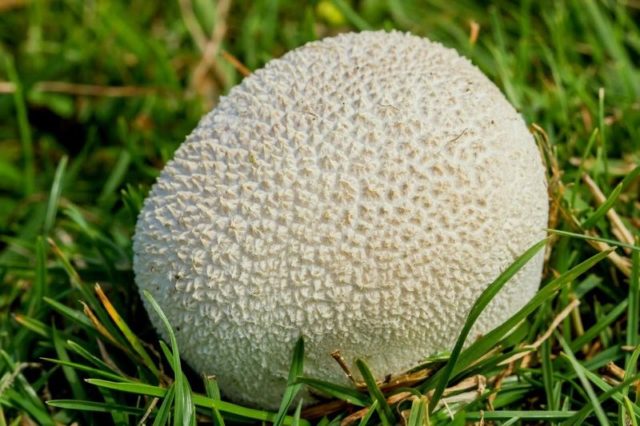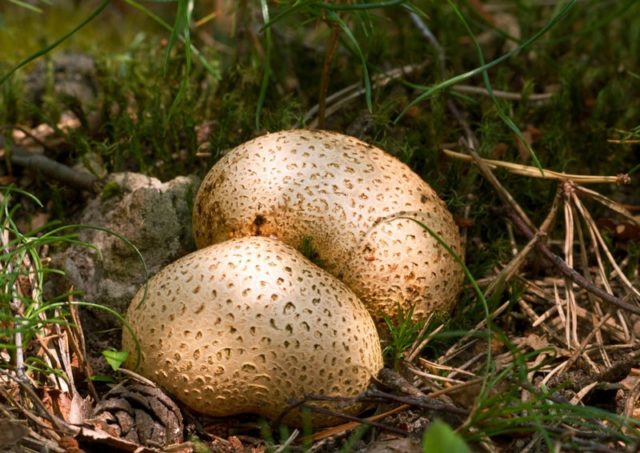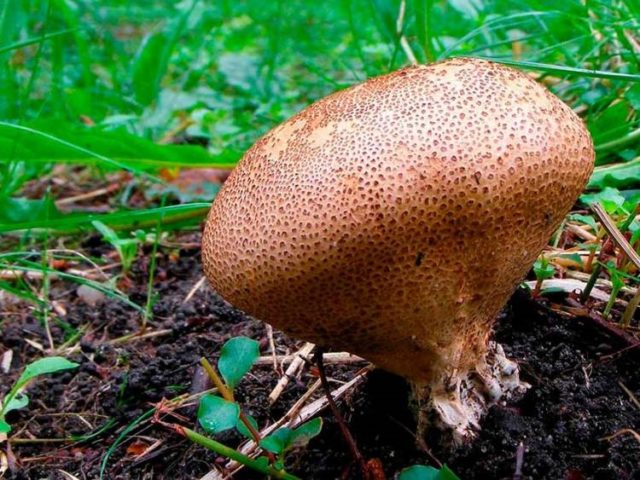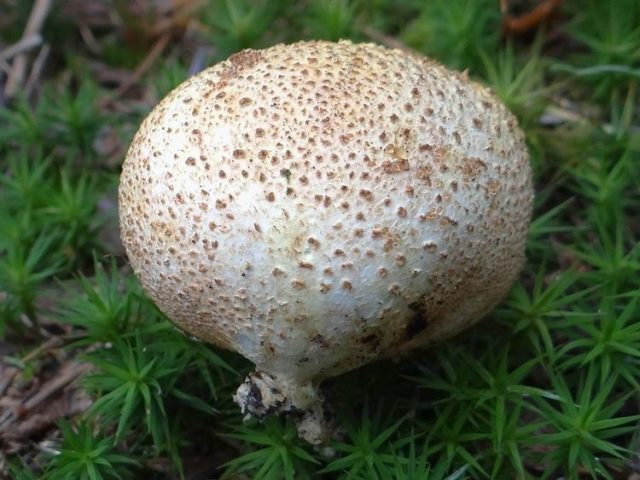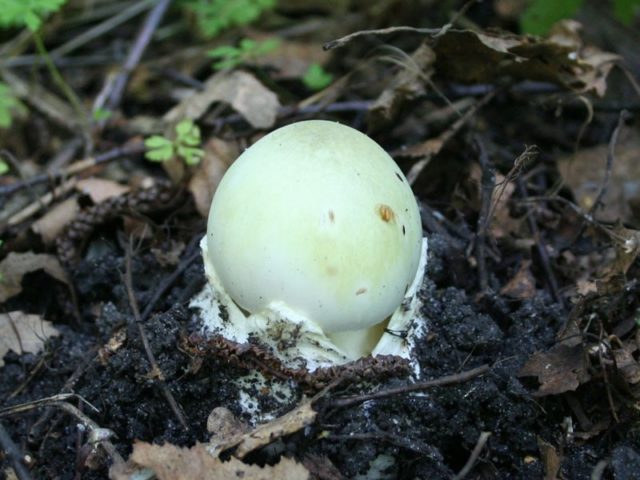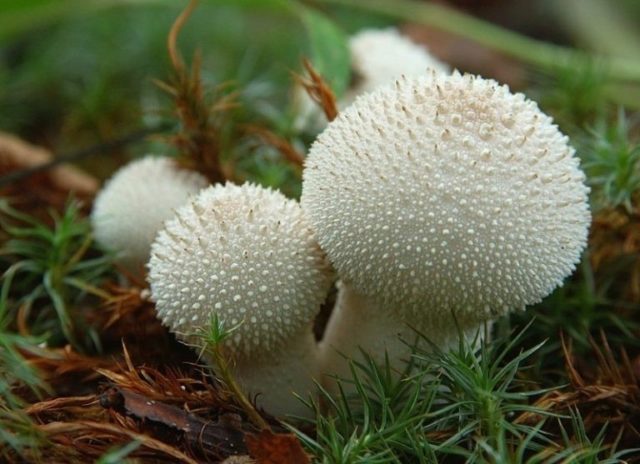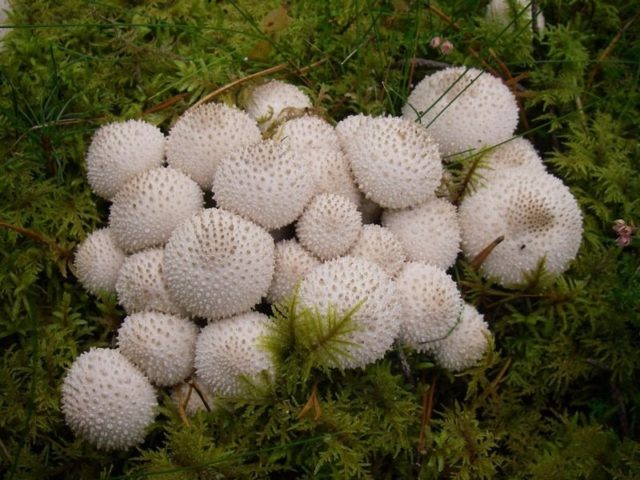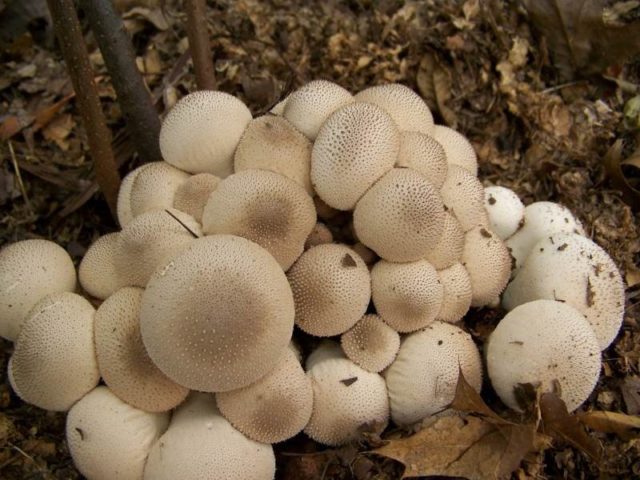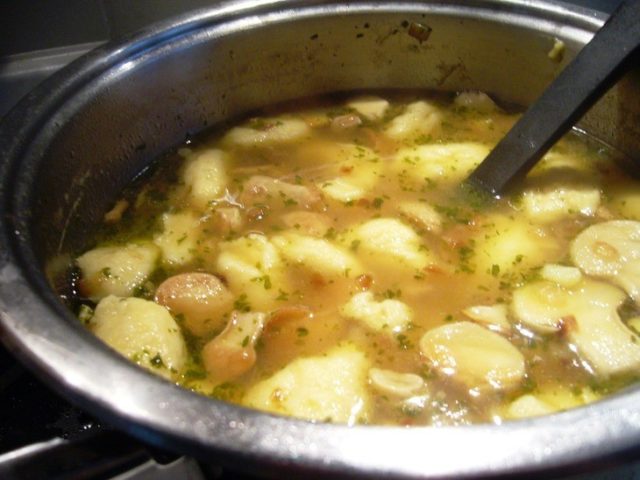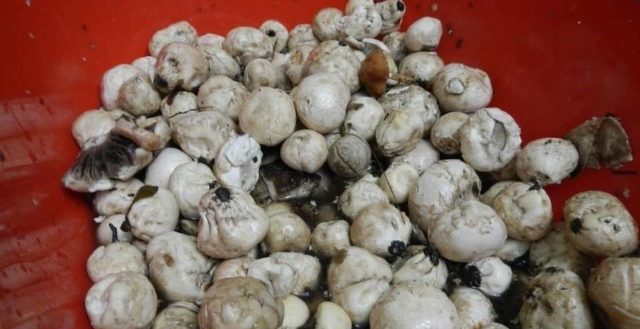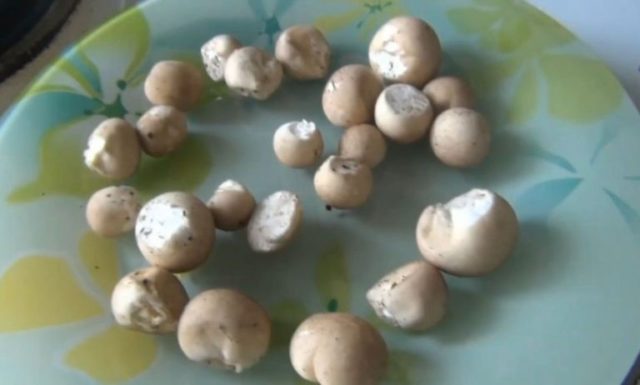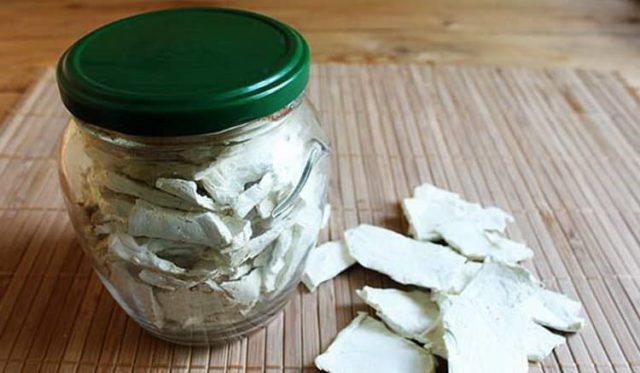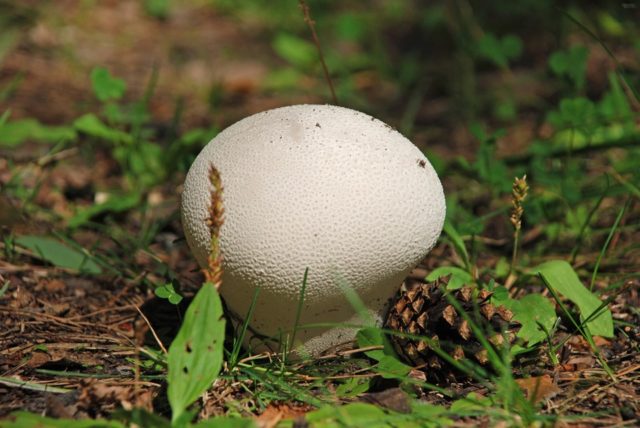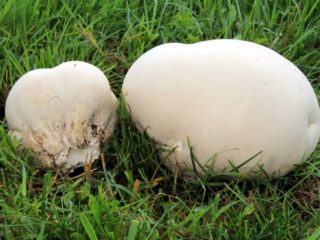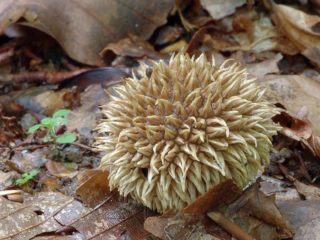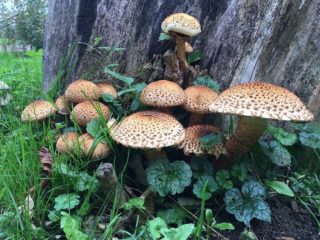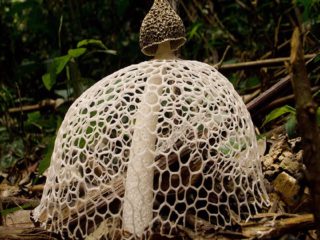Content
Edible puffball is an unusual mushroom with numerous beneficial properties and good taste. To understand how to use it with benefit and pleasure, you need to study its description and photo.
Description of the edible raincoat
Edible puffball appears under many names; it is also called real or pearl puffball, or spiny puffball. Popular names such as hare potato, grandfather's tobacco or duster, devil's apple or tobacco mushroom are common.
Externally, the duster is clearly recognizable; it has a characteristic pear-shaped or club-shaped fruiting body, where the stem gently flows into the cap. The diameter of the upper spherical part, or cap, is from 2 to 5 cm. The lower cylindrical part, or leg, reaches 2 cm in girth and rises to 6 cm in height. In young puffballs, the fruiting body is white, warty and spiny, while in adults it is brown or ocher, smooth and without thorns. The skin of the fruiting body is a kind of two-layer shell, smooth on the outside and leathery on the inside.
The flesh of the edible puffball is white and loose; the young fruiting bodies are suitable for collection and consumption. Over time, puffballs become powdery, their flesh turns brown and dries out; if you hit such a mushroom, it will scatter like tobacco. Such fruiting bodies are no longer suitable for collection.
Doubles and their differences
Since the edible puffball has a very unusual appearance, it can be confused with only a few mushrooms. These are mainly related species of puffballs, some of which are not suitable for consumption.
Common false raincoat
The common, or lemon, false puffball has an ovoid fruiting body of similar structure, about 6 cm in height, the surface of the mushroom is covered with darkish scales. The false puffball is not suitable for food, but it is quite easy to distinguish it from the edible one - the color of the inedible species is most often light brown or brownish, the flesh is yellow when cut.
False puffball warty
This mushroom also has a structure characteristic of puffballs - the fruiting body does not have a pronounced stem and cap, but is more reminiscent of an oblong potato in shape and size. The warty false mushroom in the upper part is covered with characteristic growths that look not like thorns, but like warts. It is not used in food, it is mildly toxic and can cause nausea and stomach pain.
You can distinguish the warty false puffball from the edible one by the absence of thorns and by the pulp when cut. In the first, it is milky white with yellowish veins; as the mushroom matures, it darkens.
Spotted Puffball
The spotted variety has the same fruiting body as the pearl edible puffball, but differs in color. Although the mushroom itself is white or light yellow when young, its surface is covered with small brown spots, giving the dust mole a leopard-print color.
False puffballs are not eaten as they can cause intestinal upset.The species can be distinguished by several characteristics - by color, by the absence of thorns on the top of the pseudo-puffball, by the very dense skin covering the fruiting body.
Death cap
The most dangerous counterpart of the edible puffball is the toadstool. In adulthood, it is impossible to confuse the edible dust fly with the deadly toadstool, but the young fruiting bodies have a certain similarity. An inexperienced mushroom picker may mistake a toadstool for a raincoat while it is in the “egg” stage and barely rises above the ground, representing a convex, elongated white fruiting body without a pronounced stalk.
The species can be distinguished from each other by their skin; in the duster it is rough, covered with warty growths-spines, while the young pale grebe is completely smooth.
Where and how does it grow
In Russia and throughout Eurasia, the mushroom is widespread - it can be found in the Central region, in the south, in the northern regions, and in the Far East. Edible puffball grows in coniferous and mixed forests and meadows, on roadsides and pastures; the species is not too demanding on soils. It appears most often after heavy rains, which explains its name.
Sometimes you can see the puffball one by one, but more often it bears fruit in small groups. The species grows from early summer until late autumn; it is found from early June until November.
Is the mushroom edible or not?
Contrary to stereotypes, pearl puffball belongs to the category of edible and quite tasty mushrooms. It can be processed in almost all ways, but there is one condition - only young fruiting bodies with dense white pulp are suitable for consumption.
Composition and calorie content of edible raincoats
Edible puffball not only has a delicate, pleasant taste, but can also be beneficial for the body. The composition of its young pulp includes:
- fats and polysaccharides;
- antibiotic compounds;
- vitamins and minerals;
- valuable amino acids, including leucine;
- tyrosine;
- ergosterol;
- calvacic acid and digestive enzymes.
Among the beneficial properties of edible puffball, one can note its increased nutritional value, even higher than that of champignon. The calorie content is low - only 27 kcal per 100 g of pulp.
How to prepare edible raincoats
The edible mushroom is suitable for all cooking methods; it can be boiled and fried, pickled and frozen. But, first of all, it is necessary to process the fruiting bodies - after collecting, they are carefully cleaned of debris, trying not to damage the pulp, and the rough outer skin is removed. Then the skin on the pulp is picked up with a knife and carefully rolled with your fingers.
The peeled pulp is cut into small pieces, at the same time checking for the absence of worms, and boiled in the standard way for 15-20 minutes in salted water.
Recipes for making edible raincoats
Several recipes for preparing young raincoats are especially popular. After initial processing, you can prepare an edible raincoat in any way - fry it, add it to soup, or make a separate dish with vegetables and sour cream.
Fried puffballs
The simplest recipe suggests first boiling and then frying the mushroom pulp. This is done like this:
- boiled fruit bodies are cut and rolled in flour;
- put the mushrooms in a frying pan greased with vegetable oil, salt to taste and fry for only 5-10 minutes;
- The finished dish is topped with any sauce, mushrooms are mixed with sweet peppers or onions, and then served.
You can eat mushroom pulp with boiled potatoes or pasta; the dish will be nutritious and tasty.
Raincoat soup
Another simple recipe is mushroom pulp soup. Boiled raincoats should be cut into small slices, lightly fried in a frying pan, and then added to chicken broth with onions and finely chopped carrots. Boil the soup for about 10 minutes; before serving, you can also add canned peas and some herbs to the broth.
Raincoats with sour cream and potatoes
Raincoats combined with potatoes, sour cream and onions are a delicious stand-alone dish. The recipe looks like this:
- 300 g of potatoes are peeled and lightly boiled in salted water;
- while the potatoes are boiling, peel and wash 500 g of raincoats, and then fry them in a frying pan for 20-25 minutes;
- after this, until a pleasant golden hue is obtained, fry 2 onions cut into half rings in a frying pan, add mushrooms to the onions, pepper and salt to taste;
- Fry the onions and mushrooms for another 15 minutes, and shortly before they are ready, add 2 tablespoons of sour cream.
After this, the mushroom pulp with onions remains to be removed from the stove and served together with the potatoes.
Preparing edible raincoats for the winter
Several recipes suggest preparing fruiting bodies for long-term storage.In this case, it will be possible to use edible raincoat in dried, pickled or salted form even in winter.
Pickling
A simple recipe for pickling edible raincoats looks like this:
- fresh mushrooms are processed before cooking and boiled for only 20 minutes;
- then the raincoats are placed in sterile jars and filled with hot marinade;
- The marinade itself is prepared on the basis of mushroom decoction - add 20 g of salt and sugar to the hot broth, simmer over low heat for 2 minutes and pour in 60 ml of vinegar.
The jar of pickled mushrooms is tightly closed and cooled under a warm blanket, and then stored in the refrigerator.
Canning
Another quick recipe is canning edible puffballs:
- About 500 g of mushroom pulp is boiled in salted water for 40 minutes.
- Then lightly fry 3 onions and 1 chopped carrot in a frying pan.
- Mushrooms and vegetables are mixed and crushed to a puree, and then 20 ml of vinegar are added and placed in sterile jars.
The resulting mushroom “caviar” is suitable for use with most dishes and can be stored in the refrigerator all winter.
Drying
Raincoats are suitable for drying - they are stored in this form for a long time, and you can add them to any hot dishes. There are 2 ways to dry mushrooms:
- Naturally. Fresh raincoats are cleaned of forest debris, wiped with a clean cloth, and then strung on a thread and hung in one of the rooms in a ventilated place. When all the moisture has evaporated from the pulp, the dried mushroom will be ready for use.
- In the oven. The raincoats are cleaned of adhering debris and cut if necessary, placed on a wire rack and first dried at 45 °C, and then the temperature is raised slightly and the fruiting bodies are dried at 60 °C for another 3 hours.
In the latter case, the oven door should be slightly open to prevent the temperature from rising too high.
Pickling
The most basic recipe for preparing food for the winter is pickling edible raincoat. You just need to boil the mushroom pulp for 15 minutes, and then place it in layers in a glass jar, sprinkling each layer with salt. When the jar is full, it will need to be covered with gauze and a weight placed on top.
After a few days, the mushrooms will release a large amount of juice, and after another month they will be ready for consumption.
Freezing
Another recipe suggests freezing edible young dustwort for the winter; it can be removed and used for cooking at any time. Fresh mushrooms are cleaned of adhering debris and lightly wiped, then cut into medium-sized slices, placed in plastic containers and sent to the freezer.
There is no need to boil mushrooms before freezing. You just need to make sure that the fruiting bodies are dry; if they are too wet, this will negatively affect the quality of the product.
The healing properties of edible raincoats
Pearl raincoats have numerous beneficial properties - the fruiting bodies are used in folk medicine. In particular, these mushrooms:
- used to heal wounds and cuts - the pulp stops bleeding, disinfects tissue and accelerates healing;
- used for the treatment and prevention of cancer - calvacin in the mushroom shows good antitumor properties;
- used to remove toxins and waste from the body - raincoats even allow you to get rid of heavy metals and radionuclides.
The pulp of pearl puffballs is used to create drugs aimed at combating bronchial asthma and tuberculosis, diabetes and thyroid diseases. It is useful to consume fruiting bodies for angina pectoris, hypertension, kidney diseases and varicose veins, reduced immunity and elevated temperature.
Is it possible to grow edible raincoats on the site?
Edible puffballs are suitable for growing on your own; you can grow them in your summer cottage and not have to worry about searching for fruiting bodies in the forest.
Since mushrooms actively release spores, collecting material for growing an edible puffball will not be difficult. You need to wait until the mushrooms are completely ripe, and then collect the required amount of spores in a prepared container.
Then you need to choose a suitable place on the site - preferably, it should be located in the shade, in sparse grass, on moist soil. The seeds of the edible puffball are sown in loosened soil, lightly sprinkled and forgotten about until the next season; there is no need to care for the puffball spores in any way.
Fruiting bodies on the sown area will appear in a year if the place was chosen correctly.From time to time the area will need to be sown with new spores, this will ensure a good annual yield.
Conclusion
Edible puffball is a healthy and quite tasty mushroom with good culinary properties. Only young fruiting bodies are suitable for consumption, but they can be processed using all existing methods.
